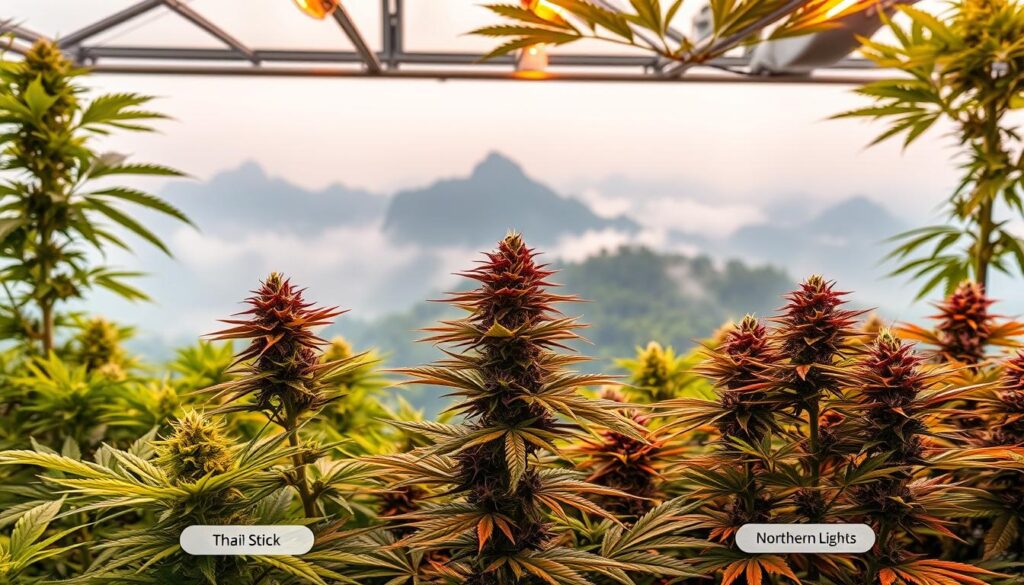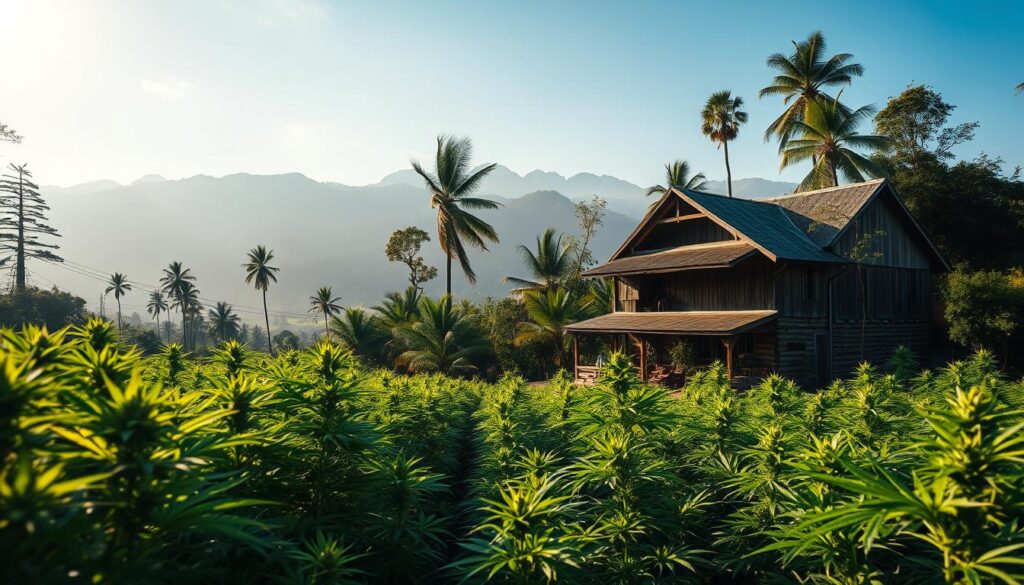Chiang Rai in northern Thailand has a perfect climate for growing cannabis. It’s warm, rainy, and has rich soil. But, you must know the local laws first.
Thailand now lets people grow cannabis, but there are rules. This guide makes those rules easy to follow. It also gives tips for growing in Chiang Rai’s special weather and soil.
Starting with your first seed or improving your skills, we’ve got you covered. We’ll talk about picking strong strains and controlling humidity. By the end, you’ll know how to grow weed in Chiang Rai legally and successfully.
Key Takeaways
- Chiang Rai’s climate supports year-round growth with proper seasonal adjustments
- Always verify current legal requirements before starting your cultivation project
- Local soil composition may require specific nutrient supplements
- Beginner-friendly strains adapt better to the region’s weather patterns
- Microclimates within Chiang Rai can significantly impact plant health
- Community resources exist for compliant growers seeking advice
Understanding Local Laws Surrounding Weed in Chiang Rai
Chiang Rai’s weed laws are complex. They mix national rules with local twists. Knowing these rules is key, whether you grow for fun or business.
The Legal Framework of Cannabis in Thailand
In 2022, Thailand became the first in Southeast Asia to legalise cannabis. The Narcotics Code Amendment took cannabis out of Category 5. Now, homes can grow up to six plants if registered with the FDA. But, extracts with more than 0.2% THC are still very controlled.
“Registration isn’t just paperwork – it’s your legal shield. Without it, even six plants could land you in hot water.“
Recent Changes in Legislation
The 2022 reform was a big step for growers. But, 2023’s Cannabis Act brought more rules. Now, you must:
- Submit cultivation plans to the Provincial Agriculture Office
- Verify strains meet THC limits through approved labs
- Renew licences annually for commercial operations
Chiang Rai is watching big grows near borders. This shows Thailand’s aim to stop illegal exports.
Growing for Personal Use vs. Commercial Purposes
Personal and commercial growing have different rules:
| Factor | Personal Use | Commercial |
|---|---|---|
| Plant Limit | 6 registered plants | No set limit |
| Licence Type | FDA notification | Commercial cultivation licence |
| Local Requirements | None | Chiang Rai business permit |
Small growers can get free soil tests from Chiang Rai’s district offices. This shows they follow quality standards. Big growers need to pay for regular checks and follow organic cultivation rules in protected areas.
Selecting the Right Strain for Chiang Rai’s Climate
Choosing the right cannabis for northern Thailand’s weather is key. Chiang Rai’s high humidity, monsoons, and hills need special strains. We’ll look at how to pick the best plants for your area.

Factors to Consider for Optimal Growth
Three important things help pick the right strain:
- Humidity tolerance: Find strains that handle 70-80% RH well
- Flowering period: Choose plants that grow during dry times, like November-February
- Mould resistance: Look for strains with tight buds to fight off mould
| Strain | Flowering Time | Mould Resistance | Yield (g/m²) | Elevation Suitability |
|---|---|---|---|---|
| Thai Stick | 8-9 weeks | High | 450-500 | 300-700m |
| Northern Lights | 7-8 weeks | Medium-High | 550-600 | 0-500m |
| Acapulco Gold | 9-10 weeks | Medium | 400-450 | 500-1000m |
Popular Strains for Beginners
New growers might like these easy options:
Thai Stick is a local hit, grown for centuries in Southeast Asia. It’s good for hot, humid weather because of its tall, airy growth.
Northern Lights grows fast, perfect for avoiding rain. It’s short and bushy, great for small spaces.
Acclimatising Seeds to Local Conditions
When introducing new strains:
- Start with 50% shade for 2-3 weeks
- Slowly add more sun each day
- Use fungi to help roots grow strong
Watch the night temperatures closely. Many hybrids need 10-15 days to get used to Chiang Rai’s cool evenings.
Setting Up Your Grow Space in Chiang Rai
Setting up your cannabis grow area in Chiang Rai is key. It’s not just helpful, it’s essential. You can use a spare room or outdoor terraces. Planning well ensures your plants do well and follow local rules.
Indoor Vs. Outdoor Growing Environments
Deciding between indoor and outdoor growing depends on your needs. Here’s a quick look:
| Factor | Indoor | Outdoor |
|---|---|---|
| Initial Cost | Higher (lights, ventilation) | Lower (natural sunlight) |
| Pest Control | Easier to manage | Requires netting/shelters |
| Monsoon Readiness | Not affected | Needs raised beds/coverings |
Outdoor growers need monsoon-resistant shelters and pest-proof netting. These are found in Chiang Rai’s cannabis market. Indoor growers use hydroponic systems, but need to watch pH levels closely.
Necessary Equipment for Healthy Growth
What you need depends on your setup. But here are some basics:
- pH meters (critical for nutrient absorption)
- Organic fertilisers like fish emulsion or compost tea
- Oscillating fans for air circulation
- Watering systems with drainage controls
Local shops in Chiang Rai have climate-adapted gear. This includes humidity controllers and UV-stabilised plastics. Always check product certifications before buying.
Key Considerations for Space Preparation
Three important things for your grow area:
- Ventilation: Prevent mould with cross-breezes or exhaust systems
- Light exposure: 18 hours daily for vegetating plants (indoor) or strategic outdoor positioning
- Security: Discreet placement respecting Thai privacy laws
For outdoor spaces, test soil drainage by pouring 5 litres of water. It should drain fully in 10 minutes. If not, add perlite or build raised beds.
Essential Growing Techniques for Beginners
To grow well in Chiang Rai, your plants need special care. This includes the right soil, water, and protection from pests. We’ll cover the basics to help you grow strong plants in this unique place.

Soil Composition and Quality
Chiang Rai’s soil is rich but tricky. It holds water and nutrients well. Make your soil better by adding:
- Composted organic matter (30% ratio)
- Perlite or coco coir for air
- Mycorrhizal fungi from local shops
These help your soil hold water but not too much. They keep roots healthy in wet and dry times.
Watering and Nutrient Needs
Water your plants when it rains a lot. Here’s how:
- Use raised beds for better water flow
- Water only when the top 5cm of soil is dry
- Give slow-release fertilisers every month
In dry times, water in the morning. This cuts down on water loss. Always check the soil’s pH. Aim for 6.0-6.5 for best nutrient use.
Pest Management and Prevention
Keep pests like spider mites away with natural methods:
- Neem oil sprays (apply weekly)
- Plant marigolds with your cannabis
- Use diatomaceous earth barriers
For big pest problems, go to Green Leaf Chiang Rai. They offer organic pest solutions. Their team can suggest the best options for your plants and follow Thai laws.
Harvesting and Curing Your Weed
Getting the timing right for harvest and curing is key in Chiang Rai’s warm weather. Use a jeweller’s loupe to check trichomes. Look for milky-white glands with a hint of amber for the best quality. Use the cannabis grow calendar for Thailand to guide you.
When to Harvest: Signs to Look For
Watch for pistil colour changes and trichome growth. Brown pistils and curled calyxes mean it’s time. In Chiang Rai’s November-December, dry buds fast to avoid mould. Remove sugar leaves right after cutting.
Techniques for Proper Curing
Hang buds in dark places with 50-60% humidity for 7-10 days. Use hygrometers to keep the right humidity. When stems snap, move buds to airtight glass jars. Open them every day for two weeks. This method boosts terpene flavours and reduces harsh tastes.
Storing Your Harvest for Maximum Freshness
Use vacuum-sealed containers with humidity packs to keep it fresh for a year. Store in cool, dark places. Chiang Rai’s weed tourism shows off traditional clay jars that keep the right temperature. But remember, sharing homegrown weed is still illegal.
Visiting Chiang Rai’s cannabis scene teaches you about curing. Local workshops teach Thai stick methods. But always check the laws first. Your cured weed is a personal win and a peek into northern Thailand’s cannabis journey. weed in Chiang Rai

